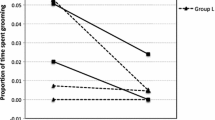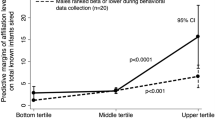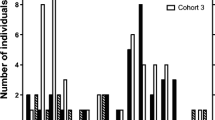Abstract
Marmosets and tamarins are characterized by a reproductive strategy that includes twinning, and a communal rearing system in which infant care is shared among all group members, both breeders and nonbreeding helpers (often older offspring). In order to test some predictions about the extent to which different age-sex classes should invest in infants, contributions to infant carrying and food-sharing by all family members were measured in captive groups of cotton-top tamarins (Saquinus oedipus) ranging in size from 2 to 12 independent individuals. Fourteen litters were observed from birth to 12 weeks. Carrying by mothers decreased steadily over the study period, while carrying by fathers and other offspring increased for 3–5 weeks, then declined. Infants spent more time carried by siblings than by either parent, but parents did more carrying than individual siblings and, also, shared more food with infants. Older siblings contributed more care than younger siblings did. Adult sons carried infants more than adult daughters did, but immature daughters carried more than immature sons did. However, adult daughters actively offered food to infants more than any other class of helper did. These results were interpreted in the light of hypotheses concerning the reproductive and dispersal strategies of callitrichid species.
Similar content being viewed by others
References
Bekoff, M., and Wells, M. C. (1982). Behavioral ecology of coyotes: Social organization, rearing patterns, space use, and resource defense.Z. Tierpsychol. 60: 281–305.
Box, H. O. (1977). Quantitative data on the carrying of young captive monkeys (Callithrix jacchus) by other members of their family groups.Primates 18: 475–484.
Cebul, M. S., and Epple, G. (1984). Father-offspring relationships in laboratory families of saddle-back tamarins (Saguinus fusciollis). In Taub, D. M. (ed.),Primate Paternalism, Van Nostrand, New York, pp. 1–19.
Cleveland, J., and Snowdon, C. T. (1984). Social development during the first twenty weeks in the cotton-top tamarin (Saguinus o. oedipus).Anim. Behav. 32: 432–444.
Dunbar, R. I. M. (1988).Primate Social Systems., Croom Helm, London.
Emlen, S. T. (1982). The evolution of helping. II. The role of behavioral conflict.Am. Nat. 119: 4–53.
Emlen, S. T. (1984). Cooperative breeding in birds and mammals. In Krebs, J. R., and Davies, N. B. (eds.),Behavioural Ecology: An Evolutionary Approach, 2nd ed., Blackwell Scientific Oxford, pp. 305–339.
Epple, G. (1975). Parental behavior inSaguinus fuscicollis ssp. (Callithricidae).Folia Primatol. 24: 221–238.
Epple, G. (1978). Reproductive and social behavior of marmosets with special reference to captive breeding.Prim. Med. 100: 50–62.
Evans, S. (1984). Captive management of marmoset and tamarins. In Laboratory Animal Science Association and Universities Federation for Animal Welfare (eds.),Standards in Laboratory Animal Management, Part 2, UFAW, Potters Bar, pp. 250–252.
Feistner, A. T. C., and Chamove, A. S. (1986). High motivation towards food increases food-sharing in cotton-top tamarins.Dev. Psychobiol. 19: 439–452.
Feistner, A. T. C., and Price, E. C. (1990). Food-sharing in cotton-top tamarins (Saguinus oedipus).Folia Primatol. 54: 34–45.
Garber, P. A., Moya, L., and Malaga, C. (1984). A preliminary field study of the moustached tamarin monkey (Saguinus mystax) in north-eastern Peru: Questions concerned with the evolution of a communal breeding system.Folia Primatol. 43: 17–32.
Gaston, A. J. (1978). The evolution of group territorial behavior and cooperative breeding.Am. Nat. 112: 1091–1100.
Goldizen, A. W. (1987). Facultative polyandry and the role of infant-carrying in wild saddle-back tamarins (Saguinus fuscicollis).Behav. Ecol. Sociobiol. 20: 99–109.
Goldizen, A. W., and Terborgh, J. (1986). Cooperative polyandry and helping behavior in saddle-backed tamarins (Saguinus fuscicollis). In Else, J., and Lee, P. C. (eds.),Primate Ecology and Conservation, Cambridge University Press, London, pp. 191–198.
Hoage, R. J. (1978). Parental care inLeontopithecus rosalia rosalia: Sex and age differences in carrying behavior and the role of prior experience. In Kleiman, D. G. (ed.),Biology and Conservation of the Callitrichidae, Smithsonian, Washington, DC, pp. 293–305.
Ingram, J. (1977). Interactions between parents and infants, and the development of independence in the common marmoset (Callithrix jacchus).Anim. Behav. 25: 811–827.
Ingram, J. (1978). Preliminary comparisons of parental care of wild-caught and captive-born common marmosets. In Rothe, H., Wolters, H.-J., and Hearn, J. P. (eds.),Biology and Behaviour of Marmosets, Eigenverlag Rothe, Göttingen, pp. 225–231.
McGrew W. C. (1987). Helpers at the nest-box, or, are cotton-top tamarins really Florida scrub jays?Prim. Rep. 18: 21–26.
McGrew, W. C. (1988). Parental division of infant caretaking varies with family composition in cotton-top tamarins.Anim. Behav. 36: 285–286.
McGrew, W. C., and McLuckie, E. C. (1986). Philopatry and dispersion in the cotton-top tamarin,Saguinus (o.) oedipus: An attempted laboratory simulation.Int. J. Primatol. 7: 399–420.
Moynihan, M. (1970). Some behavior patterns of platyrrhine monkeys. II.Saguinus geoffroyi and some other tamarins.Smith. Contrib. Zool. 28: 1–77.
Mumme, R. L., and de Queiroz, A. (1985). Individual contributions to cooperative behaviour in the acorn woodpecker: Effects of reproductive status, sex, and group size.Behaviour 95: 290–313.
Price, E. C. (1990). Infant carrying as a courtship strategy of breeding male cotton-top tamarins.Anim. Behav. 40: 784–786.
Price, E. C. (1991a). The benefits of helpers: Effects of group and litter size on infant care in tamarins(Saguinus oedipus). Am. J. Primatol. (in press).
Price, E. C. (1991b) Competition to carry infants in captive families of cotton-top tamarins(Saguinus oedipus). Behaviour (in press).
Price, E. C. (1991c). Stability of wild callitrichid groups.Folia Primatol. (in press)
Price, E. C., and McGrew, W. C. (1990). Cotton-top tamarins (Saguinus (o.) oedipus) in a semi-naturalistic captive colony.Am J. Primatol. 20: 1–12.
Pryce, C. R. (1988). Individual and group effects on early caregiver-infant relationships in red-bellied tamarin monkeys.Anim Behav. 36: 1455–1464.
Rood, J. P. (1978). Dwarf mongoose helpers at the den.Z. Tierpsychol. 48: 277–287.
Rylands, A. B. (1985). Infant-carrying in a wild marmoset group,Callithrix humeralifer: Evidence for a polyandrous mating system. In de Mello, M. T. (ed.),A Primatologia no Brasil, Vol. 2., University of Brasilia, Brasilia, pp. 131–144.
Savage, A. (1990).The Reproductive Biology of the Cotton-Top Tamarin (Saguinus oedipus oedipus)in Colombia, Ph.D. dissertation, University of Wisconsin-Madison.
Stallcup, J. A., and Woolfenden, G. E. (1978). Family status and contributions to breeding by Florida scrub jays.Anim. Behav. 26: 1144–1156.
Sussman, R. W., and Garber, P. A. (1987). A new interpretation of the social organization and mating system of the Callitrichidae.Int. J. Primatol. 8: 73–92.
Tardif, S. D., Carson, R. L., and Gangaware, B.L. (1986). Comparison of infant care in family groups of the common marmoset (Callithrix jacchus) and the cotton-top tamarin (Saguinus oedipus).Am. J. Primatol. 11: 103–110.
Tardif, S. D., Richter, C. B., and Carson, R. L. (1984). Effects of sibling-rearing experience on future reproductive success in two species of Callitrichidae.Am. J. Primatol 6: 377–380.
Tardif, S. D., Carson, R. L., and Gangaware, B. L. (1990). Infant-care behavior of mothers and fathers in a communal-care primate, the cotton-top tamarin (Saguinus oedipus).Am. J. Primatol. 22: 73–85.
Vogt, J. L., Carlson, H., and Menzel, E. (1978). Social behavior of a marmoset (Saguinus fuscicollis) group. I. Parental care and infant development.Primates 19: 715–726.
Wolters, H. J. (1978). Some aspects of role taking behaviour in captive family groups of the cotton-top tamarinSaguinus oedipus oedipus. In Rothe, H., Wolters, H. J., and Hearn, J. P. (eds.),Biology and Behaviour and Marmosets, Eigenverlag Rothe, Göttingen, pp. 259–278.
Woolfenden, G. E., and Fitzpatrick, J. W. (1978). The inheritance of territory in group-breeding birds.BioScience 28: 104–108.
Ziegler, T. E., Bridson, W. E., Snowdon, C. T., and Eman, S. (1987). Urinary gonadotropin and estrogen excretion during the postpartum estrus, conception, and pregnancy in the cotton-top tamarin (Saguinus oedipus oedipus).Am. J. Primatol. 12: 127–140.
Author information
Authors and Affiliations
Rights and permissions
About this article
Cite this article
Price, E.C. Contributions to infant care in captive cotton-top tamarins (Saguinus oedipus): The influence of age, sex, and reproductive status. International Journal of Primatology 13, 125–141 (1992). https://doi.org/10.1007/BF02547838
Received:
Revised:
Issue Date:
DOI: https://doi.org/10.1007/BF02547838




